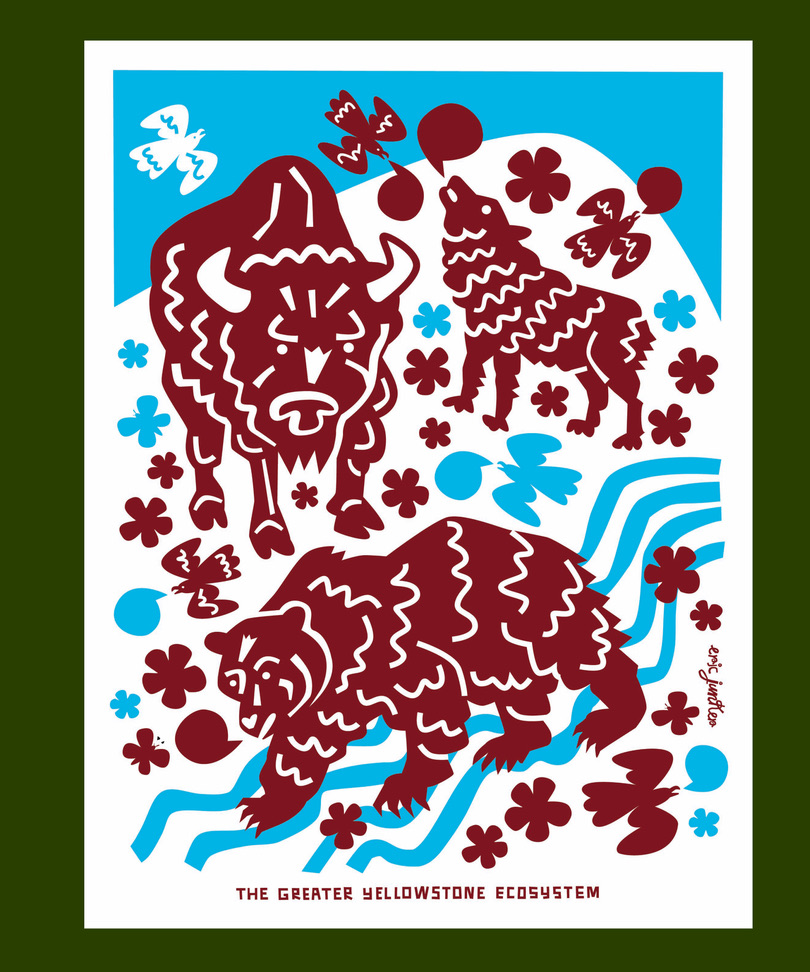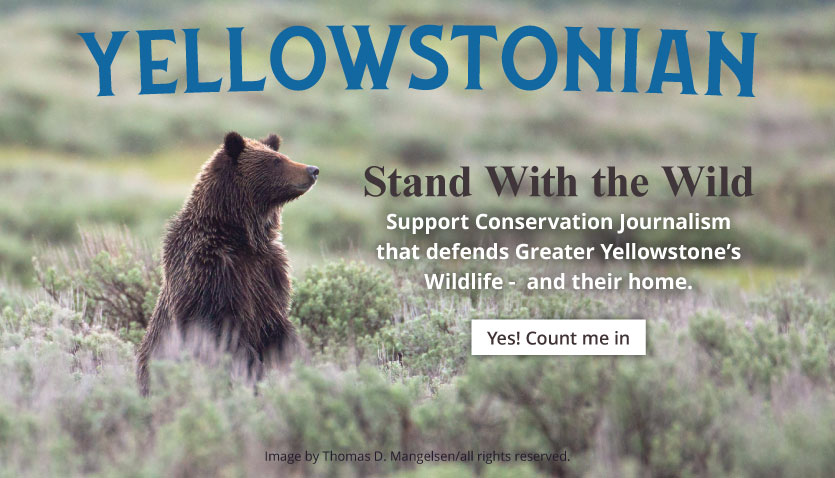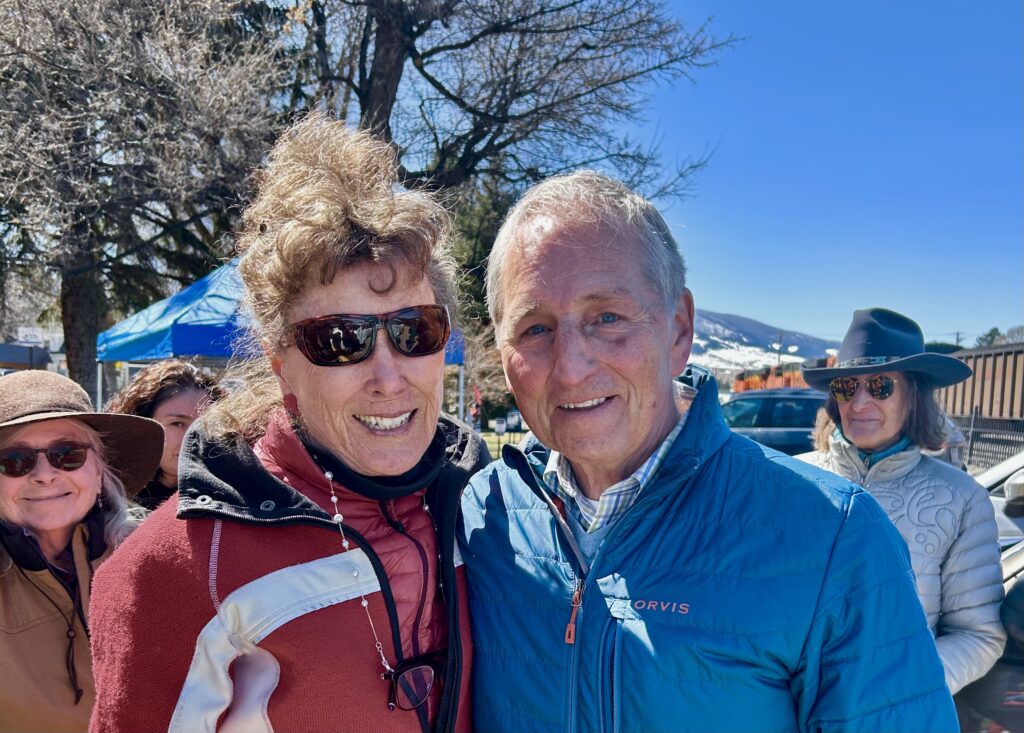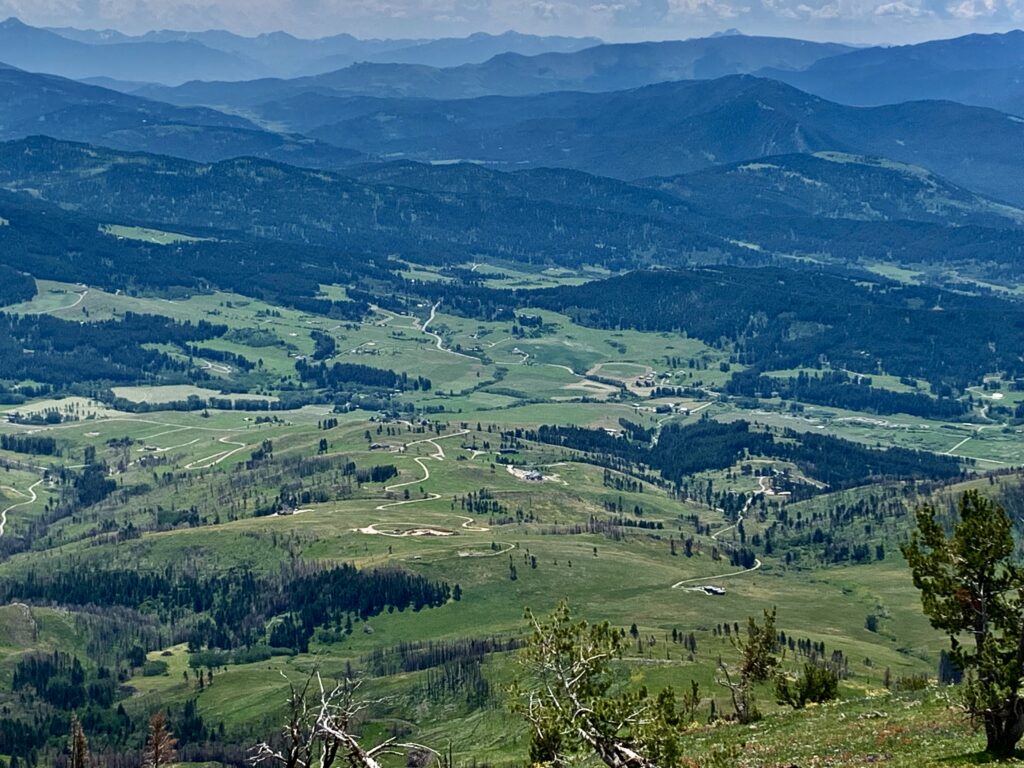By Todd Wilkinson
The day before Summer Solstice 2016 Jackson Hole Grizzly 399 was moving through the northern reaches of Grand Teton National Park alone with her single cub of the year “Snowy.” Snowy had been given the nickname for the white patch of hair on its face and coat.
Late in the day, as mother bear and cub were crossing US Highway 191 in the park, Snowy was struck and killed by a hit-and-run driver whose identity to this day remains unknown. Witnesses who happened upon the scene shortly after described a frantic 399 standing over the mortally-injured youngster. She kept gently nudging the animal, desperately trying to get it to move.
399 wouldn’t leave Snowy’s side and eventually dragged her lifeless offspring off the asphalt. There the mother staid and bawled, leaving only after rangers removed the dead cub because they were afraid 399, too, might get hit by another car. How might a human mother had behaved differently under similar circumstances?
Over the years, Grizzly 399 and her adult still-living daughter 610, who also has raised cubs, have displayed many different expressions of what people would call intelligence, joy, comfort, concern, and, yes, affection.
When those mothers became temporarily separated from cubs while navigating the brambles of Jackson Hole, they demonstrated what appeared to be euphoric relief at being reunited—immediately laying on their backs and inviting the panicked cubs to suckle some warm milk as a way of re-connecting.
At one point, in a year when 399 and 610 each had new litters of cubs (5 in all), the family members converged on a carcass and fed on it together as the cubs played. That same year, when 399 appeared haggard from tending to triplets, 610 “adopted” one cub, adding it to her two, and raising it as her own, apparently to give her mother a break.
These instances are not fictions fit for a Disney movie; they really happened, and they’re part of the mystique not only of 399 and her legend, but they’ve taught millions of people around the world to have more appreciation, empathy and compassion for grizzlies and other species.
Dr. Marc Bekoff isn’t surprised by any of this. His new book, featuring a foreword from Jane Goodall, is titled The Emotional Lives of Animals: A Leading Scientist Explores Animal Joy, Sorrow, and Empathy—and Why They Matter.

The book’s cover features a photograph of a wolf mother offering succor to a pair of pups. In light of recent events in Sublette County, Wyoming that have made headlines around the globe, and as a counterpoint perhaps to defiant anti-wolf rhetoric coming from ranchers in Colorado over the recent introduction of wolves there, Bekoff’s tome is exceedingly topical, timely and provocative.
Just because certain humans want to deny that animals lack personalities informed by intelligence and emotions does not mean they do not exist, he says.
Few scientists in America, whose primary passion is the natural world, have been more outspoken about matters of ethology, a branch of zoology that studies the behavior of non-human beings. For years, Bekoff, who is professor emeritus in the Department of Ecology and Evolutionary Biology at the University of Colorado-Boulder, has also written a widely-read column, Animal Emotions, for the national magazine Psychology Today. It has notched more than 10.6 million views.
Bekoff is well aware of the resistance that comes from some who refuse to accept other creatures who share the planet with us, and whose evolution is far older than our own, are sentient. That is to say they have feelings. As a substantial body of emerging studies have confirmed, scientists in the field of ethology say there’s a lot more going on with animals than we think. Such assertions still are disregarded by some as a bunch of New Age woo-woo.
Fully 40 pages of Bekoff’s book are devoted to the scientific studies he cites. The appendices follow 189 pages of easy to read narrative in which he makes a strong case for “how ignorant our species has been in appreciating the complexity of other beings.” His message isn’t preachy or condescending; rather, it invites us, as sapient beings, to pay closer attention to the animals around us and then try to convince ourselves they don’t have ineffable spirit.
As evidence, he notes, one need not wander far: interact with a pet dog, cat or horse who welcomes us every time we arrive home or makes sounds of contentment when we’re out for a ride. Watch a rescue dog that was beaten or abused by its former owner and see it warm up, allowing humans to redeem ourselves and then see the deeper sense of trust and vital companionship flow both ways. Bekoff says the same kind of empathy and compassion we feel for the “domestic” creatures we cherish exists in the societies of those animals’ wild cousins apart from us. And there’s much each of us can learn—if only we dare.
Watch a rescue dog that was beaten or abused by its former owner and see it warm up, allowing humans to redeem ourselves and then see the deeper sense of trust and vital companionship flow both ways. Bekoff says the same kind of empathy and compassion we feel for the “domestic” creatures we cherish exists in the societies of those animals’ wild cousins apart from us. And there’s much each of us can learn—if only we dare.
In Jackson Hole, there’s Grizzly 399. In Yellowstone, bison—like African elephants—have been observed converging upon a fallen herd member who died and then made physical contact with it, as if mourning its passing, before walking away. Otter families have been viewed sliding down slopes of snow into rivers, over and over again, like human kids out sledding. Ravens have demonstrated remarkable “thinking” behavior in moving around objects or amassing collections of things that vary from bird to bird. Prairie dogs have a wide range of vocalizations that members of colonies use in interactions with other community members. Coyotes and badgers hunt together recognizing each other’s strengths.
Within the traditions of indigenous people in North America, clans were named after differing animals in deference to their admirable behavioral characteristics.
As a field biologist earlier in his career, Bekoff studied the social ecology and behavior of coyotes in Wyoming and he credits the earlier work of noted Jackson Hole biologist, conservationist and filmmaker Dr. Franz Camenzind. Those years served as a prelude to three epiphanies Bekoff had: first, that the animal world is interwoven and complex; second, that human biases against each other and other species usually stem from lack of knowledge; and thirdly, humans are more likely to persecute, abuse, torture or malign creatures they don’t understand, or animals that don’t serve their economic interests or rigid forceful commands.
Like retired Yellowstone Park ranger Rick McIntyre, who has written several best-selling books about the wolves of Yellowstone (and which have changed the way they are perceived), Bekoff has witnessed peoples’ lives become transformed when they begin seeing what’s actually happening beyond their own insulated shells. When they open themselves up, they discover that other species exhibit their own versions of love, joy, yearning for connection, fun, and they suffer the pain of trauma and loss.
Below are excerpts from a recent conversation I had with Bekoff about his new book.
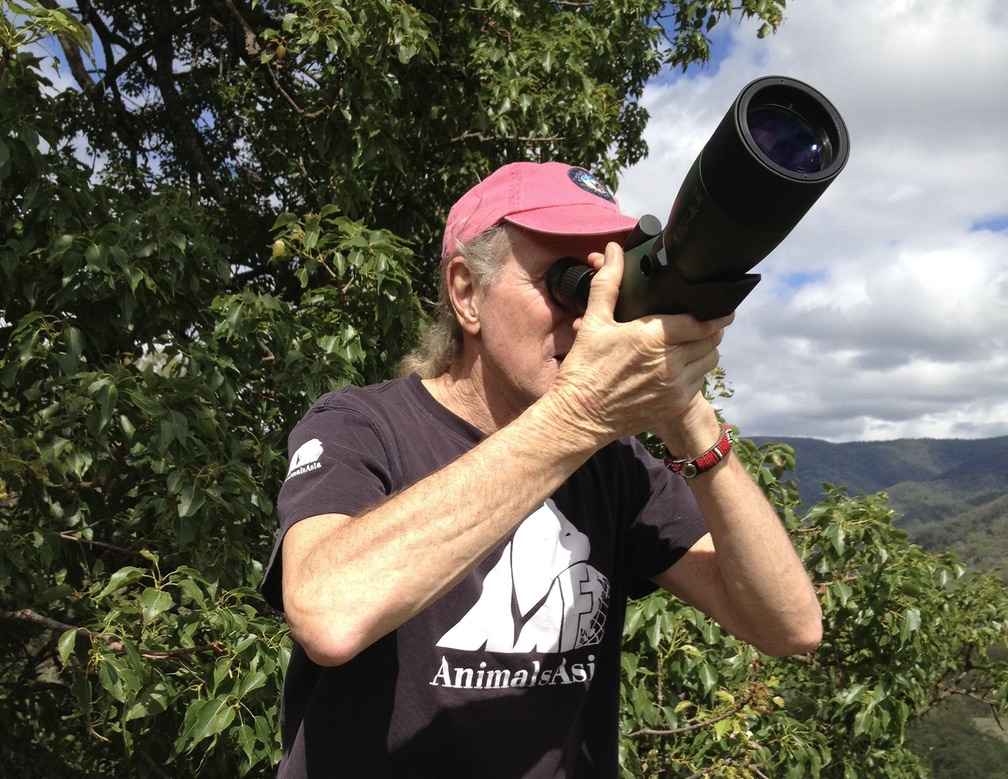
Todd Wilkinson: Your new book is a revised and updated edition of voluminous previous books you’ve written. It is an impressive display of accumulated data. What, for you, are a few of the important takeaways that appear in this edition that weren’t in the others?
MARC BEKOFF: So, the first edition of The Emotional Lives of Animals appeared in 2007. A lot of has happened and emerged in the years’ since. There are probably at least 300 new references. To me the most important takeaway, which was present in the first edition, is that I’m tired of hearing uninformed claims that animals are lesser beings.
We’ve known this isn’t the case for centuries. The reason I sometimes get cranky is because the new welfare standards really are still not achieving what I’d like to see done in a whole realm of areas from laboratory research to wildlife conservation to entertainment, zoos and aquariums. It’s really a call to action.
TW: The book came out before the recent incident in Wyoming involving a man who allegedly drove over a young wolf with a snowmobile, then tortured and killed it. The book provides context for readers to at least reflect upon how the incident might have been viewed from the young wolf’s perspective before it was killed. Reflecting on what happened in Sublette County, what are your thoughts?
BEKOFF: The short answer is I can’t really process it because it was so obviously egregious and atrocious. I can’t fully understand how anybody would do something like that and then show off, in a kind of exhibitionist way, in front of people who defend what he did.
The one question I often ask people who do these kinds of things is: would you do it to your dog? Ninety-nine percent of people say no. And it gives me an opportunity to explain how ultimately, we are talking about sentient mammals. The dogs we love are no more sentient than wild animals. It’s possible that were I to pose the question to the guy in Wyoming and his friends, I might not want to know their answer. I wonder how they justify it to children.
“The one question I often ask people who do these kinds of things is: would you do it to your dog? Ninety-nine percent of people say no. And it gives me an opportunity to explain how ultimately, we are talking about sentient mammals. The dogs we love are no more sentient than wild animals. It’s possible that were I to pose the question to the guy in Wyoming and his friends, I might not want to know their answer. I wonder how they justify it to children.”
—Marc Bekoff
TW: You and other scientist friends have been championing for years the fact that animals have emotions, incredible intelligence and a highly evolved sense of being. What is sentience and why is acknowledging—and seeing, hearing, and smelling— sentience present in animals so difficult for some people to acknowledge and accept?
BEKOFF: Sentience is simply the truth that animals have feelings. Why is acknowledging and seeing sentience present in animals so difficult for some humans to understand? One of the things I often say is that philosophers and others will debate to death the question of whether we human beings are sentient. Actually, I don’t think it’s a very difficult concept for most people to accept. I’ve studied dogs a lot, and the way I bring it home to people who have dogs, who have lived with dogs or have friends with dogs, is you immediately see the shared feelings between species when you’re in their company. Your feelings serve as a social bond and what I call a social glue. We see it human to human, but it is also present between dogs, cats and people and when you know this, it’s not a big step to appreciate that it exists within the social behavior of other species. One more thing I’d say is that embracing sentience does not guarantee you’ll be a good, kind person. There are people who recognize animals are sentient beings and that they have feelings and still they will do horrible things to them. That is more about the character and pathology of the person not the animal.
TW: To follow up on that, let me ask you this: do you think that a person who does not have sympathy for what happened to the wolf in Wyoming is not a sentient human?
BEKOFF: That’s a difficult question and a harder one to answer. I would have to say that in certain situations like this, there are people who inflict pain on other animals, and they know damn well that the animals are sentient. But I think it’s also a matter of empathy. I’ve been getting tons of emails about this, but I would pose a rhetorical question and it would go like this; how can somebody not have any empathy for what that young wolf was going through when it clearly it was in complete terror and displaying pain?
TW: Do you see any political solutions emerging in Wyoming that would extend animal cruelty laws more fully to wildlife carnivores such as wolves, coyotes, bobcats and foxes?
BEKOFF: Well, we know that Wyoming Governor Mark Gordon is no Kristi Noem, thank goodness. And I can only hope that he and other leaders will work to make those sorts of necessary commonsense changes—extending dignity, respect and compassion to other animals that he, as a rancher and role model, readily offers, no questions asked, to his own dogs, horses and cattle. He knows the difference between what’s right and what’s clearly wrong. [Noem is the current governor of South Dakota who attracted national controversy for writing in her own memoir that she took her young dog, Cricket, out to a gravel pit and shot it out of frustration because it was “less than worthless as a hunting dog.” She also shot a goat because it was “nasty and mean.”]
“Well, we know that Wyoming Governor Mark Gordon is no Kristi Noem, thank goodness. And I can only hope that he and other leaders will work to make those sorts of necessary commonsense changes—extending dignity, respect and compassion to other animals that he, as a rancher and role model, readily offers, no questions asked, to his own dogs, horses and cattle. He knows the difference between what’s right and what’s clearly wrong.”
— Bekoff
TW: For a time earlier in your career, you studied coyote behavior in Wyoming. What did you come to more fully appreciate not only about coyotes but the culture of human persecution of wildlife carnivores that still persists in the West?
BEKOFF: From 1977 to 1983, my students and I studied social behavior and social ecology of coyotes. Coyotes display incredible variability and flexibility in social behavior and social organization. Some of the groundwork for our research was done by Franz Camenzind in Jackson Hole, whom I greatly admire.
We knew coyotes were persecuted but what I came out of the research with, after thousands of hours of watching coyotes, is respect for just how adaptable they are. Franz had identified it. Although what people have been saying for a long time and continue to say now, is that it’s their flexibility and adaptability so clearly demonstrated which makes it so difficult to manage or control them because they are survivors. Native Americans refer to them as cunning tricksters.
I think one of the reasons that so many of the students I worked with wanted to continue studying them over the years is because almost every day there was some surprise. It wasn’t like watching the same thing happening over and over again, every day. Eradication doesn’t work. It is brutal and costly in so many ways. The best strategy is for ranchers to use non-lethal methods which can get you closer to where you want to be. Plus, it’s hard not to love the yips and songs of coyotes; it’s part of the soundtrack of the natural West.
TW: Ethologist Frans de Waal is mentioned in several places in your book, and he recently passed away. What were some of his most meaningful contributions to our better understanding of non-human animal behavior?
BEKOFF: It was very sad that we lost him. He opened a new frontier in thinking about sentience in animals and now it’s really widespread. He wrote a lot about empathy. One of his books was titled Chimpanzee Politics: Power and Sex Among Apes, which I found, when I read it many years ago, to be very important and interesting. He was looking at the social interactions among chimpanzees as a kind of political system. He identified behaviors like reciprocity, selfishness and other similar sorts of interactions, not altogether different from what we see in human politics.
Science is not always accessible, and I think Frans de Waal’s major contribution was that his books were readable and understandable to a broad audience. He had a knack for bringing together complex scientific data, in bits and pieces, in ways people could read. I try to do the same.
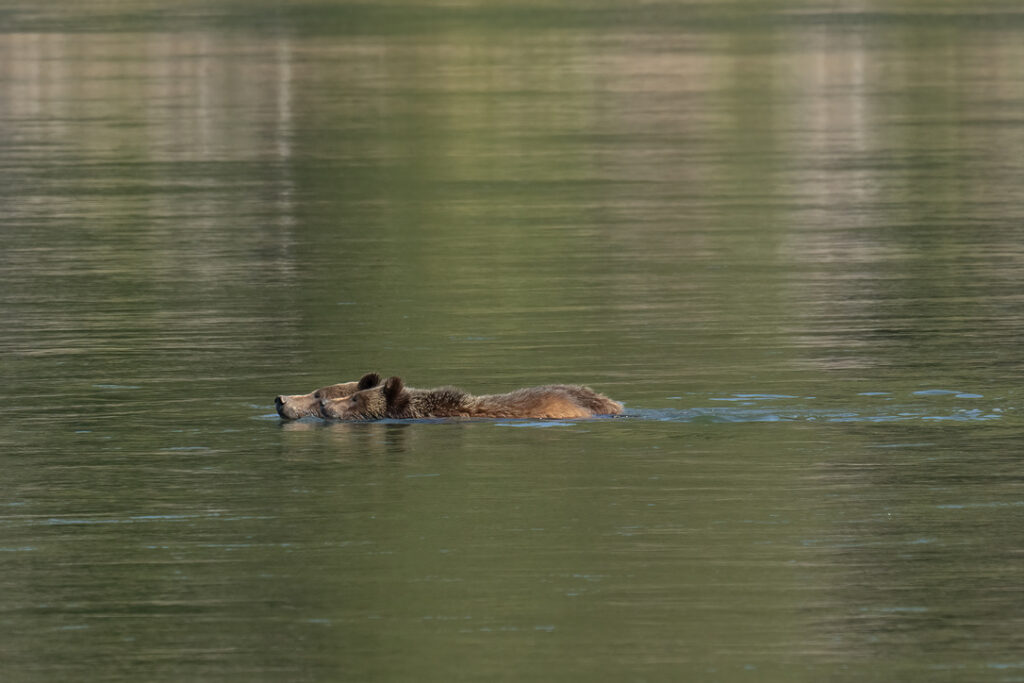


TW: We’ve spoken about this phenomenon on several occasions over the years and it involves what you describe as both situational ethics and morality. As you’ve noted, we create categories of “good” and “bad” animals and then we place the so-called bad ones into special status to justify our mistreatment of them. Western states do this with carnivores and using the term “vermin.” Your thoughts?
BEKOFF: We tend to demonize species by using the worst most extreme anecdotes to generalize. If a grizzly bear harms a human, then we classify grizzlies as being extremely dangerous even though encounters are actually exceedingly rare given the number of people in grizzly country. We do the same with sharks. We rationalize that we need to kill them before they do something “bad.” The way I usually answer this is that just like there are bad apples among humans, if you will, there are animals who can cause problems or kill people. They’re very few but you know, like people, individual animals can suffer from various psychopathologies and it’s important to have the maturity to view the outliers as the exceptions rather than the rule. Some can be unusually aggressive and cause injuries to us or other animals.
TW: You have a look on your face right now. What’s up with that?
BEKOFF: I want to make it really clear that I’m not talking about predatory animals because when I go to meetings, I will hear people say that all coyotes, wolves and other predators are bad because they kill other animals. Well, humans are predators and some of us murder or torture each other. Wildlife predators kill to eat and that’s how they’ve evolved. But what they don’t do, exceptionally in extremely rare occasions, is kill us.
“Being threatened by new facts, or digging your heels in and denying them does not make those facts go away. I’ve learned a lot over the past 40 years. Data demonstrate patterns of behavior that have evolved across many species. Individuals live in a pack or a herd or a flock for a reason. As social animals, individuals have to be able to work together to achieve common goals or else their society will dissolve. This is one of the main threats currently jeopardizing the future of America.“
—Bekoff
TW: Often we hear the argument, unproven, that animals go on killed sprees and kill for fun.
BEKOFF: What I think is really interesting in this general question is that many animals have been studied, including coyotes and wolves, and even some birds, and they seem to live by some sort of “golden rule”: treat others as you would have them treat you. A lot of mammals exhibit this during play behavior and there are codes of conduct or a mutual understanding. You invite another animal to play, and you and they stick to the rules of the game. I’m here to play, I’m not trying to eat you, mate with you or beat you up. In these interactions you often see compassion and empathy. I reference many examples of this in the book, including among species like tigers.
TW: But animals do fight and sometimes they die.
BEKOFF: I want to be clear that this doesn’t mean other animals don’t have conflicts or behave aggressively and don’t on occasion harm one another. I’ve been seriously misquoted as supposedly saying this doesn’t happen. It does. And it can be difficult to watch. I think it’s fair to say that humans have more difficulty co-existing with other animals than other animals do with each other You see that in a places like Yellowstone. To return to Frans de Wall, he really highlighted reciprocity, empathy, and cooperation among individual animals, though there are times when they will break down, just like it breaks down in among humans. No other single large species in the last 300,000 years has been more lethal. We’ve literally wiped other species from the map.
TW: You readily admit that your own thinking continues to evolve.
BEKOFF: Being threatened by new facts, or digging your heels in and denying them does not make those facts go away. I’ve learned a lot over the past 40 years. Some of these ideas were percolating in my brain when I was a young academic and when I was studying coyotes. What we’ve seen in recent decades is the accumulation of a huge database that’s been amassed from comparative research on different animals. The data demonstrate patterns of behavior that have evolved across many species. Individuals live in a pack or a herd or a flock for a reason. As social animals, individuals have to be able to work together to achieve common goals or else their society will dissolve. This is one of the main threats currently jeopardizing the future of America.

TW: There’s an interesting passage in the foreword of your book from your good friend Jane Goodall. She reflects on her research with chimpanzees and the resistance she received from her then-elders in academia who refused to see animals as unique individuals with unique personalities and she also mentions the pronouns used to refer to nonhumans. It was kind of like the pronoun controversies of today, only in reverse. She writes: “When I submitted my first scientific paper for publication in Nature, the editor crossed out everywhere I had written ‘he’ or ‘she’ and substituted ‘it.’ Were they [chimps] even to be deprived of their gender? I crossed out each ‘it’ and underlined every ‘he’ and ‘she’. And that [version of my paper] was published.” Is past prologue, and if so, where is our human society headed with how we think about the other beings with whom we share this planet?
BEKOFF: Jane is a dear friend and obviously an amazing woman, and she’s been an indefatigable ambassador for animals. But people forget or are unaware that she persevered amid highly entrenched attitudes that were rooted in the past. She knew the chimpanzees very well and the science had to catch up to where her thinking was.
When she was doing her work in Gombe she saw wild chimpanzees as unique individuals with unique personalities. She named them and referred to individuals as “he” and “she,” not a group of “its.” When she left the field and went back to the University of Cambridge, she was chastised for naming the animals and talking about personalities. It’s easy to see after decades of doing research and looking at the results of other studies that have followed her groundbreaking work, she was right. Naming nonhumans is very important. We name our dogs, cats, and horses, but we don’t number them. Oftentimes, research animals or food animals are numbered, which devalues their individuality. Naming an individual really means that there’s a special relationship.
TW: You note how there is a human yearning to relate to animals. How is this evolving?
BEKOFF: Why do you think there’s such a proliferation of companion and comfort dogs? We need animals in our lives and many people consciously find it more satisfying to seek comfort in animals than other humans. People work with and ride horses and interact with them as a form of therapy. Dogs and cats can help unlock kids who are dealing with autism and we can contribute much to the lives of animals. Domestic animals value their contact with us, too.
TW: You delve into anthropomorphism, which is interpreting nonhumans through a lens of perception and language that we typically use when referencing each other. What are the aspects of anthropomorphizing that you think are helpful in thinking about human-non-human interactions and what are the areas that are of concern?
BEKOFF: In the big picture, we’ve moved past much of the misplaced worry about it. Very few people are concerned with “being anthropomorphic.” I still see it with a few people working in state and federal wildlife agencies who are resistant to acknowledging distinct individuals in populations of animals, but they’re behind the times and they use it as an excuse not to accept that the general public and even their peers are very enthusiastic about the animals they like to watch or study.
What it comes down to is that we need to use a common language to explain the behavior and social interactions of humans and nonhumans. And so we call some animals “friendly” or “aggressive.” We say that some are “suffering” after a long winter or that a population is “thriving.” Trophy hunters will call a bull elk “beautiful” or “gorgeous” before they kill it, stuff it and put it on their wall. All of this is now done without people being accused of being anthropomorphic.
“What it comes down to is that we need to use a common language to explain the behavior and social interactions of humans and nonhumans. And so we call some animals ‘friendly’ or ‘aggressive.’ We say that some are ‘suffering’ after a long winter or that a population is ‘thriving.’ Trophy hunters will call a bull elk ‘beautiful’ or ‘gorgeous’ before they kill it, stuff it and put it on their wall. All of this is now done without people being accused of being anthropomorphic.”
—Bekoff
TW: Please continue. I can assure you that this type of conversation is not happening in the state legislatures of Wyoming, Montana and Idaho, nor on university campuses in wildlife biology classes in those states.
BEKOFF: We use human words foremost to describe animal behavior so that we can better relate to other animals. It makes their essence as beings more comprehensible. There will come a time when the way we approach thinking about the animal world now will be viewed as backward. Some years ago, I was at a zoo standing in front of an elephant. I remarked that she looked miserable and sad and a guy next to me said, “Oh, you’re being anthropomorphic. She’s actually very happy.” This led to a discussion and the point I made was why is it anthropomorphic to say the animal was suffering but it’s not anthropomorphic to claim the animal is happy?
TW: I’ve heard you use similar references in describing how perceptions can be different in the rural West with ranchers and certain wildlife species.
BEKOFF: I’m interested in having honest conversations and it’s important that we understand what our referential biases are. It always amazes me that a rancher may characterize wolves and coyotes as being “vicious killers” if they eat “a beloved calf” but they don’t seem to have any problem that calves are being raised so that one day they’ll be trucked to a feedlot and then will end up at a slaughterhouse, walking single file behind other cows, until they meet their fate. How would the same rancher describe that death experience and do they think about what was is the mind of those animals?
TW: You bonded with pets early in your life. In your book you note the myriad reciprocal benefits that come with adopting a more compassionate view of animals. What does viewing wildlife and respecting its space and giving it a voice do for us?
BEKOFF: With animals like dogs and cats, the research is clear that when we give them love and kindness, they feel it. And studies show that our endorphins and neurons are activated.
In general, when people adopt more compassionate views of animals we form social bonds with them and that kind of connection soothes and relaxes us. We and they reap the benefits of having a compassionate relationship. What’s good for us is good for them and what’s bad for them is bad for us.
TW: You have spoken about why pursuing high-adrenalyn exercise is different from immersing oneself in the outdoors with all of our sensory attenae switched on.
BEKOFF: I think there’s sizable mass of people who feel alienated from nature and I wrote about this in my book. All you need to do to feel better when you’re down and out is take a walk. But something extraordinary happens when listen for the sight and sounds of other animals. What comes to mind when I think about Rachel Carson’s classic book Silent Spring is that people didn’t appreciate the birdsongs until they realized they were gone. We need to not only open up spaces in our hearts to be more compassionate toward animals; we also need to give them the space they need to live and coexist with us in various landscapes. We need to up our level of awareness.
“I say let’s not mess Greater Yellowstone up by making the same mistakes other regions have. The world around Greater Yellowstone has changed radically, and the same pattern will continue to happen unless humans are willing to accept limits on how we consume the outdoors and adopt an ethic that respects the natural world. If we want the species of Greater Yellowstone to survive and thrive, we need to do more than approach every decision based on what will deliver the maximum personal benefits to us.”
—Bekoff
TW: Before we end this, I want to say that your book caused me to think more broadly and deeply about the nature of human-animal interactions and I would encourage everyone to pick up a copy. I like to end every interview by asking the subject to say a few words about Greater Yellowstone. You’ve described it as a refuge from the developed world that dominates most landscapes, including the Front Range of the Colorado Rockies where you live.
BEKOFF: I say let’s not mess Greater Yellowstone up by making the same mistakes other regions have. The world around Greater Yellowstone has changed radically, and the same pattern will continue to happen unless humans are willing to accept limits on how we consume the outdoors and adopt an ethic that respects the natural world. We’re merely visitors to public lands but they are the homes for diverse wildlife. If we want them to survive and thrive, we need to do more than approach every decision based on what will deliver the maximum personal benefits to us. We need to be more compassionate and empathic about the struggles other animals face, many of which have been and are continuing to be caused by the things we selfishly do as if the well-being of the nonhumans doesn’t really matter.
Simply saying that we care about other animals without respecting what they want and need to live good lives is narrowly and arrogantly anthropocentric. It is happening and as they lose their identity and their homes and become unable to live natural lives. In their absence, we suffer too, sometimes without even realizing it. When we respect what they want and need and allow them to thrive, it’s a win-win for all.
Subscribe
Never miss a story, subscribe to our newsletter!
Support Yellowstonian and
Get Some Real Cool Visual Stuff
From now through the end of July, Livingston-based Artemis Institute, the parent non profit entity of Yellowstonian, is participating in the Park County, Montana Community Foundation’s Give a Hoot fundraiser and all contributions made to Artemis Institute will support Yellowstonian‘s mission of providing conservation journalism focused on Greater Yellowstone. We would be profoundly grateful for your support and here’s your chance to get a cool reward: Anyone who contributes $35 or more will receive their pick of one individual species poster below or all three for $100. For a donation of $350 or more, supporters will receive a special, limited-edition collector’s lithograph that features all three of Greater Yellowstone’ species’s icons. It is hand-signed by Eric Junker.
